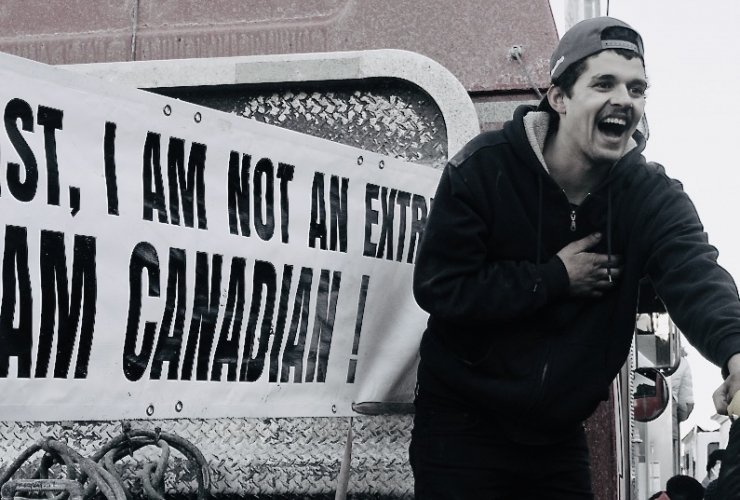Canada’s police forces took different approaches to protests against COVID-19 measures over the weekend, learning from the situation in Ottawa, where protesters and their trucks have remained barricaded in the center of the capital for more than a week. week.
Thousands of people opposing pandemic-related restrictions rallied in cities across the country in solidarity with the Ottawa rally, but though the gatherings were large and noisy, they seemed to end peacefully as the weekend drew to a close. .
In Toronto, protesters arrived on the grounds of the Ontario legislature Saturday, mostly on foot, after police closed off stretches of downtown streets to ensure access to nearby hospitals. A slightly smaller group moved just north of the area to an intersection blocked by some tractor-trailers that had managed to drive downtown.
But by 8 p.m., the trucks, cars and protesters that had packed the area left peacefully, a stark contrast to what has been happening in Ottawa.
“Our number one goal was really to keep those big trucks out of the area,” Toronto’s superintendent of personnel said. Lauren Pogue, part of the team planning the response to the protest.
“We allow them to demonstrate peacefully, but on foot, not with vehicles. We don’t need big tractor trailers in our downtown area.”
There was a heavy police presence over the weekend, including officers on horseback and a riot squad of about 30 officers, who then moved in to briefly take control of the intersection north of the legislature. Reinforcements from other police forces were also brought in.
what people are reading

Police only made one arrest: someone allegedly lit a smoke bomb outside the Ontario legislature. No one was injured during the protests and the force received only two noise complaints, despite horns blaring for several hours, Pogue said.
Toronto police “made it very clear” to protesters that no one would be staying overnight, Pogue said, and police had heavy tow trucks at the ready.
“No one is judging (Ottawa police), but we will always consider what we are seeing and how that might work in Toronto and how we can prevent those things from happening,” he said. “It was a very good day.”
What other police forces in Canada have learned from the #Ottawa protests. #cdnpoli
Police in Quebec City also saw large crowds dissipate on Sunday night.
Protesters and trucks began arriving in the area outside the National Assembly on Thursday night. By Saturday, thousands of protesters and dozens of trucks were in the area as families attended the nearby Quebec Carnival. The last protesters and trucks left the area Sunday at dinner time.
Authorities made three arrests and handed out 170 tickets for municipal violations, traffic safety code violations and illegal parking during the four-day event.
Police Chief Denis Turcotte said Monday that he believes the event went smoothly thanks to the collaboration between protesters and police.
“The situation, the environment, the clientele, the way they deployed in Ottawa versus how we did here, it’s very different in each area,” Turcotte said.
“I can’t comment on why it went one way in Ottawa and how it happened here. We adapted to the situation we faced and it worked out well.”
On the West Coast, Vancouver police knew a planned convoy of hundreds of trucks was headed downtown over the weekend and decided to let them in.
“Our goals were to keep traffic moving, keep that disruption to a minimum, and provide an atmosphere in which people could participate in peaceful and legal demonstrations,” said Sgt. Steve Addison.
“We certainly wanted to avoid a situation like we’re seeing in other parts of the country, where we have traffic jams and blockades.”
Vocal counter-protesters ran into the convoy in an effort to stop it, with one man lying in front of a truck, he said. There were skirmishes between the two sides throughout the downtown area, Addison said. Police arrested five people, largely for minor mischief-related incidents.
“Overall, we had thousands of people come into the city, participate in peaceful and legal protests and say their part and leave,” he said. “It was a success for us.”
In Sarnia, Ontario, a demonstration Sunday near the US border caused traffic disruptions, but police said they encountered no major problems.
Dozens of tractors and trucks parked on a road leading to a bridge into the US That prompted Ontario Provincial Police to close the road after people got out of their vehicles on the west side of Highway 402.
Dozens of more tractors and trucks arrived in the center of Sarnia, causing a traffic jam for several hours, Const said. Giovanni Sottosanti.
“We had officers present to monitor the situation,” he said. “We didn’t have any problems, people came, they did what they did and then they dispersed.”
Police forces, particularly Toronto, have clearly learned from mistakes made by Ottawa police, said Michael Kempa, an associate professor of criminology at the University of Ottawa.
“They had a plan ready,” he said.
“I think the Ottawa police misjudged this group of people’s decision to stay in bed and then refuse to leave. And once you get the heavy machinery in place, it’s very difficult to move people.”
He said Ottawa police, unsure of the size of the protest or its goals, allowed the protesters to enter.
“The Ottawa police were a little reluctant to crack down for fear it would galvanize the movement,” Kempa said.
Meanwhile, other police services had a week to study the situation in Ottawa and try something different, he said.
“Law enforcement agencies are ready for them,” he said. “(The police) are making it impossible to get down in the central part and bring the city to a standstill just by controlling the flow of traffic.”
This report from The Canadian Press was first published on February 6, 2022.